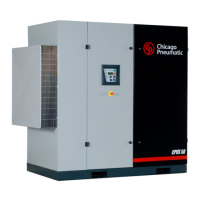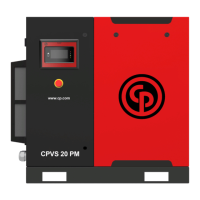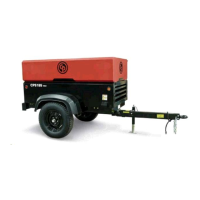Do you have a question about the Chicago Pneumatic CPVS 95 and is the answer not in the manual?
Explains symbols used for safety warnings and important notes.
Outlines essential safe working practices and regulatory compliance for operators.
Details crucial safety measures and procedures to follow during the installation phase.
Highlights critical safety guidelines to ensure safe and proper operation of the equipment.
Specifies safety protocols for maintenance, repair, and adjustment work.
Provides an overview of CPVS compressors, their design, and control system.
Explains the flow paths and components of the air and oil circuits within the compressor.
Details the load/unload regulation mechanism based on pressure and solenoid valve control.
Identifies and lists the main electrical components within the compressor's cubicle.
Introduces the ES 4000 Advanced controller and its primary functions for compressor management.
Provides a detailed description of the ES 4000 Advanced controller's control panel and its keys.
Explains various status, input, system, and menu icons used in the controller interface.
Describes the function and types of main screen views available on the controller.
Explains how to access various menus and navigate through the controller interface.
Details how to display and select analog and digital input values and signals.
Describes how to view the operational status of various outputs within the compressor system.
Explains how to access and view running hours, motor starts, and other counter data.
Guides on selecting the compressor's control mode: local, remote, or LAN.
Outlines functions for resetting, checking, and modifying service plans and intervals.
Explains how to access and adjust unloading and loading pressure bands.
Describes how to program and select setpoints for compressors with variable speed drives.
Details how to retrieve data on last shutdowns and emergency stop events.
Explains programming time-based start/stop and change-over commands for compressors.
Describes how to perform display tests and safety valve tests.
Guides on changing general settings like language, time, date, and format.
Covers general settings including language, time, date, and units.
Explains how to activate and set a personal password for enhanced security.
Describes how access levels control visibility and modification of parameters.
Lists programmable settings, including unloading/loading pressures and variable speed drive parameters.
Provides references to dimension drawing documents for various compressor models.
Discusses site requirements, including outdoor/altitude operation and free area reservations.
Illustrates and explains various pictographs used on the machine for identification and safety.
Guides through the initial steps for starting the compressor, including removing fixtures.
Lists essential checks and preparations required before initiating compressor operation.
Details the step-by-step procedure for starting the compressor and checking voltages.
Provides warnings and regulator information relevant to the compressor's operational status.
Explains the controller's built-in function for automatic compressor restart after voltage failure.
Outlines the procedures for normal stopping and emergency stopping of the compressor.
Describes the steps for safely taking the compressor unit out of service.
Details routine maintenance tasks and their recommended intervals for optimal performance.
Provides advice on proper storage procedures for the compressor unit.
Information on available service kits for maintenance and service contract options.
Guidelines for environmentally friendly disposal of used filters, lubricants, and electronic parts.
Instructions for inspecting, cleaning, replacing the air filter element, and resetting warnings.
Step-by-step guide for draining old oil, replacing the oil filter, and refilling.
Details the procedure for removing, cleaning, and replacing the oil separator element.
Advises on keeping coolers clean to maintain their efficiency.
Instructions for cleaning the air inlet and cubicle filter panels.
Explains how to operate, test, and warnings regarding safety valves.
Safety precautions and general remarks for maintaining refrigeration dryers.
Guidelines for selecting appropriate electric cable sizes and fuses based on voltage, current, and environment.
Specifies the standard conditions and operational limits for compressor performance.
Presents detailed technical data for compressor models under reference conditions.
Describes the energy recovery system, its components, and application types.
Introduces the ECO6i controller for managing multiple compressors and its activation.
Guides on connecting compressors using 4th generation controllers via Local Area Network.
Explains methods for modifying ECOi parameters via display or specialized software.
Details operation, isolation, and integration of compressors within the ECOi LAN configuration.
Covers stopping all compressors and adding external net pressure sensors to the ECOi system.
Explains the function and components of the automatic drain valve for condensate removal.
Details the heavy duty filter option for improved air intake quality, useful in dusty environments.
Describes pre-filtration panels to protect internal components and reduce contamination.
Explains the phase controller for verifying rotation direction and preventing damage.
Discusses the types of oils available and their specific applications and maintenance intervals.
Describes the device that separates condensate formed in the air cooler.
Explains the function of a tropical thermostat for higher ambient temperatures and humidity.
Details the frequency adjusting device, safety rules, and warning symbols.
Explains symbols used for safety warnings and important notes.
Outlines essential safe working practices and regulatory compliance for operators.
Details crucial safety measures and procedures to follow during the installation phase.
Highlights critical safety guidelines to ensure safe and proper operation of the equipment.
Specifies safety protocols for maintenance, repair, and adjustment work.
Provides an overview of CPVS compressors, their design, and control system.
Explains the flow paths and components of the air and oil circuits within the compressor.
Details the load/unload regulation mechanism based on pressure and solenoid valve control.
Identifies and lists the main electrical components within the compressor's cubicle.
Introduces the ES 4000 Advanced controller and its primary functions for compressor management.
Provides a detailed description of the ES 4000 Advanced controller's control panel and its keys.
Explains various status, input, system, and menu icons used in the controller interface.
Describes the function and types of main screen views available on the controller.
Explains how to access various menus and navigate through the controller interface.
Details how to display and select analog and digital input values and signals.
Describes how to view the operational status of various outputs within the compressor system.
Explains how to access and view running hours, motor starts, and other counter data.
Guides on selecting the compressor's control mode: local, remote, or LAN.
Outlines functions for resetting, checking, and modifying service plans and intervals.
Explains how to access and adjust unloading and loading pressure bands.
Describes how to program and select setpoints for compressors with variable speed drives.
Details how to retrieve data on last shutdowns and emergency stop events.
Explains programming time-based start/stop and change-over commands for compressors.
Describes how to perform display tests and safety valve tests.
Guides on changing general settings like language, time, date, and format.
Covers general settings including language, time, date, and units.
Explains how to activate and set a personal password for enhanced security.
Describes how access levels control visibility and modification of parameters.
Lists programmable settings, including unloading/loading pressures and variable speed drive parameters.
Provides references to dimension drawing documents for various compressor models.
Discusses site requirements, including outdoor/altitude operation and free area reservations.
Illustrates and explains various pictographs used on the machine for identification and safety.
Guides through the initial steps for starting the compressor, including removing fixtures.
Lists essential checks and preparations required before initiating compressor operation.
Details the step-by-step procedure for starting the compressor and checking voltages.
Provides warnings and regulator information relevant to the compressor's operational status.
Explains the controller's built-in function for automatic compressor restart after voltage failure.
Outlines the procedures for normal stopping and emergency stopping of the compressor.
Describes the steps for safely taking the compressor unit out of service.
Details routine maintenance tasks and their recommended intervals for optimal performance.
Provides advice on proper storage procedures for the compressor unit.
Information on available service kits for maintenance and service contract options.
Guidelines for environmentally friendly disposal of used filters, lubricants, and electronic parts.
Instructions for inspecting, cleaning, replacing the air filter element, and resetting warnings.
Step-by-step guide for draining old oil, replacing the oil filter, and refilling.
Details the procedure for removing, cleaning, and replacing the oil separator element.
Advises on keeping coolers clean to maintain their efficiency.
Instructions for cleaning the air inlet and cubicle filter panels.
Explains how to operate, test, and warnings regarding safety valves.
Safety precautions and general remarks for maintaining refrigeration dryers.
Guidelines for selecting appropriate electric cable sizes and fuses based on voltage, current, and environment.
Specifies the standard conditions and operational limits for compressor performance.
Presents detailed technical data for compressor models under reference conditions.
Describes the energy recovery system, its components, and application types.
Introduces the ECO6i controller for managing multiple compressors and its activation.
Guides on connecting compressors using 4th generation controllers via Local Area Network.
Explains methods for modifying ECOi parameters via display or specialized software.
Details operation, isolation, and integration of compressors within the ECOi LAN configuration.
Covers stopping all compressors and adding external net pressure sensors to the ECOi system.
Explains the function and components of the automatic drain valve for condensate removal.
Details the heavy duty filter option for improved air intake quality, useful in dusty environments.
Describes pre-filtration panels to protect internal components and reduce contamination.
Explains the phase controller for verifying rotation direction and preventing damage.
Discusses the types of oils available and their specific applications and maintenance intervals.
Describes the device that separates condensate formed in the air cooler.
Explains the function of a tropical thermostat for higher ambient temperatures and humidity.
Details the frequency adjusting device, safety rules, and warning symbols.
| Brand | Chicago Pneumatic |
|---|---|
| Model | CPVS 95 |
| Category | Air Compressor |
| Language | English |











